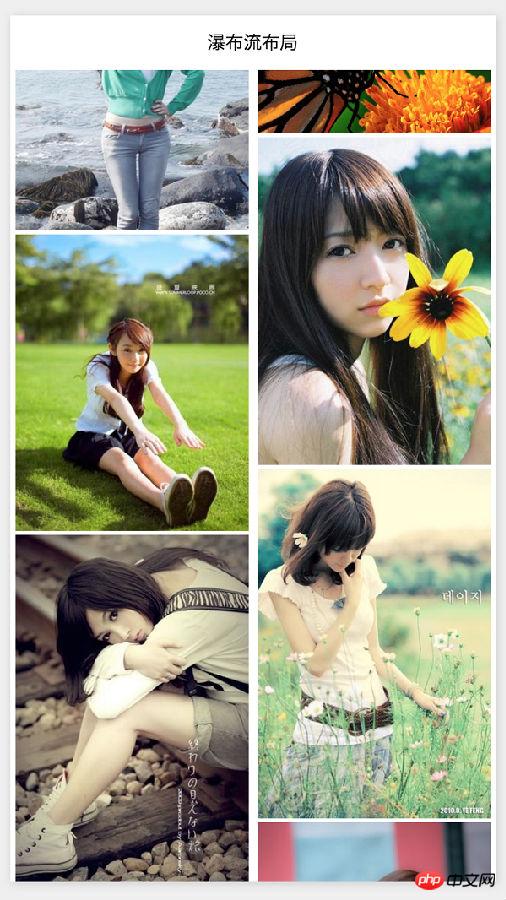
Waterfall flow layout is a popular page layout method, the most typical one is Pinterest.com , the height of each card is different, creating an uneven aesthetic.
In HTML5, we can find many waterfall flow layout plug-ins based on jQuery and the like to easily create such a layout form. In WeChat Mini Program, we can also achieve this effect, but due to some characteristics of the mini program framework, there are still some differences in implementation ideas.
Today we will take a look at how to implement this waterfall flow layout in 小program:

Waterfall flow layout of small program
What we want to implement is a fixed 2-column layout, and then dynamically load the image data into In these two columns (the loaded image will be placed in the left column or the right column based on the actual size of the image).
#/* Style of a single image container*/.img_item { width: 48%; margin: 1%; display: inline-block; vertical-align: top;}
We know that in HTML, if we want to dynamically load images, we usually use new Image() to create A picture object, and then use it to dynamically load the picture pointed to by the url and obtain the actual size of the picture and other information. In the mini program framework, there is no corresponding JS object provided to handle image loading. In fact, we can use the
Let’s take a look at the onImageLoad function defined in the Page file. In it, we can obtain rich information about the
let col1H = 0;let col2H = 0;
Page({ data: { scrollH: 0, imgWidth: 0, loadingCount: 0, images: [], col1: [], col2: []
}, onLoad: function () {
wx.getSystemInfo({ success: (res) => {
let ww = res.windowWidth;
let wh = res.windowHeight;
let imgWidth = ww * 0.48;
let scrollH = wh;
this.setData({
scrollH: scrollH,
imgWidth: imgWidth
}); //加载首组图片
this.loadImages();
}
})
}, onImageLoad: function (e) {
let imageId = e.currentTarget.id;
let oImgW = e.detail.width; //图片原始宽度
let oImgH = e.detail.height; //图片原始高度
let imgWidth = this.data.imgWidth; //图片设置的宽度
let scale = imgWidth / oImgW; //比例计算
let imgHeight = oImgH * scale; //自适应高度
let images = this.data.images; let imageObj = null;
for (let i = 0; i < images.length; i++) { let img = images[i];
if (img.id === imageId) {
imageObj = img; break;
}
}
imageObj.height = imgHeight;
let loadingCount = this.data.loadingCount - 1;
let col1 = this.data.col1;
let col2 = this.data.col2; //判断当前图片添加到左列还是右列
if (col1H <= col2H) {
col1H += imgHeight;
col1.push(imageObj);
} else {
col2H += imgHeight;
col2.push(imageObj);
} let data = {
loadingCount: loadingCount, col1: col1, col2: col2
}; //当前这组图片已加载完毕,则清空图片临时加载区域的内容
if (!loadingCount) {
data.images = [];
} this.setData(data);
}, loadImages: function () { let images = [
{ pic: "../../images/1.png", height: 0 },
{ pic: "../../images/2.png", height: 0 },
{ pic: "../../images/3.png", height: 0 },
{ pic: "../../images/4.png", height: 0 },
{ pic: "../../images/5.png", height: 0 },
{ pic: "../../images/6.png", height: 0 },
{ pic: "../../images/7.png", height: 0 },
{ pic: "../../images/8.png", height: 0 },
{ pic: "../../images/9.png", height: 0 },
{ pic: "../../images/10.png", height: 0 },
{ pic: "../../images/11.png", height: 0 },
{ pic: "../../images/12.png", height: 0 },
{ pic: "../../images/13.png", height: 0 },
{ pic: "../../images/14.png", height: 0 }
]; let baseId = "img-" + (+new Date());
for (let i = 0; i < images.length; i++) {
images[i].id = baseId + "-" + i;
} this.setData({
loadingCount: images.length, images: images
});
}
}) if (col1H <= col2H) {
col1H += imgHeight;
col1.push(imageObj);
} else {
col2H += imgHeight;
col2.push(imageObj);
} let data = { loadingCount: loadingCount, col1: col1, col2: col2
}; //当前这组图片已加载完毕,则清空图片临时加载区域的内容
if (!loadingCount) {
data.images = [];
} this.setData(data);
}, loadImages: function () { let images = [
{ pic: "../../images/1.png", height: 0 },
{ pic: "../../images/2.png", height: 0 },
{ pic: "../../images/3.png", height: 0 },
{ pic: "../../images/4.png", height: 0 },
{ pic: "../../images/5.png", height: 0 },
{ pic: "../../images/6.png", height: 0 },
{ pic: "../../images/7.png", height: 0 },
{ pic: "../../images/8.png", height: 0 },
{ pic: "../../images/9.png", height: 0 },
{ pic: "../../images/10.png", height: 0 },
{ pic: "../../images/11.png", height: 0 },
{ pic: "../../images/12.png", height: 0 },
{ pic: "../../images/13.png", height: 0 },
{ pic: "../../images/14.png", height: 0 }
]; let baseId = "img-" + (+new Date());
for (let i = 0; i < images.length; i++) {
images[i].id = baseId + "-" + i;
} this.setData({ loadingCount: images.length, images: images
});
}
})<scroll-view scroll-y="true" style="height:{{scrollH}}px" bindscrolltolower="loadImages">
<view style="width:100%">
<view class="img_item">
<view wx:for="{{col1}}" wx:key="id">
<image src="{{item.pic}}" style="width:100%;height:{{item.height}}px"></image>
</view>
</view>
<view class="img_item">
<view wx:for="{{col2}}" wx:key="id">
<image src="{{item.pic}}" style="width:100%;height:{{item.height}}px"></image>
</view>
</view>
</view>
</scroll-view>The above is the detailed content of Implement waterfall flow layout and infinite loading in WeChat mini program. For more information, please follow other related articles on the PHP Chinese website!
 What versions of linux system are there?
What versions of linux system are there?
 Usage of #include in C language
Usage of #include in C language
 What does margin mean in css
What does margin mean in css
 How to restore normal printing when the printer is offline
How to restore normal printing when the printer is offline
 What does liquidation mean?
What does liquidation mean?
 Introduction to article tag attributes
Introduction to article tag attributes
 How to start oracle data monitoring
How to start oracle data monitoring
 windows cannot open add printer
windows cannot open add printer
 Virtual mobile phone number to receive verification code
Virtual mobile phone number to receive verification code




